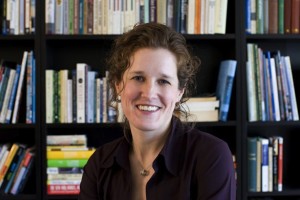Loree Griffin Burns knew when she was a young student that she loved science – and writing – and on June 1 she shared her passion for both of her life’s callings with sixth grade students at Old Hammondtown School, highlighting her book Tracking Trash: Flotsam, Jetsam, and the Science of Ocean Motion.
The story behind the children’s book began back in 1992 when shipping containers from a cargo ship fell into the sea, breaking open to release 30,000 floating bathtub toys into the Pacific Ocean. As Burns dove into the history of the accident that quickly turned into a unique study on ocean currents, she managed to weave into her presentation awareness on the damaging effects plastic is having on the oceans and marine life.
In 2003, Burns read a headline in her local newspaper that caught her attention. “Duckies floating to eastern beaches,” it read. It seemed that 11 years after the accident, these plastic bath toys had been carried from one coast to the other coast and were finally hitting the beaches of Massachusetts.
“I found this odd and fascinating at the same time,” said Burns. She found herself asking questions like, whose job was it to track 30,000 rubber ducks across the ocean? How would one do it, and, of course, why?
The idea captured her imagination, compelling Burns to contact the man who made it his business to track plastic toys floating across the globe on the ocean currents. Dr. Curt Ebbesmeyer is his name, and his passion is to understand the ocean movements and surface currents of the planet’s oceans.
Ebbesmeyer not only tracked the bath toys, but he even tracked the movement of 70,000 Nike sneakers that spilled from a shipping freighter into the Pacific Ocean off the coast of Alaska.
Burns held up a sneaker and a bathtub toy like the ones Ebbesmeyer tracked.
“What could you possibly want to track in the ocean besides junk like this?” Burns asked the students. Oil spills was the most important, said Burns. “He (Ebbesmeyer) can say where the slick will move next.”
Burns found Ebbesmeyer and the bathtub toy accident “quirky and interesting,” resulting in her children’s book that explores the flow of the ocean currents and, ever so gently, exposes a growing problem of trash and plastic junk in the world’s oceans in a way that wasn’t “depressing,” she said.
Charles Moore, a scientist with whom Burns worked while researching the material for the book, also worked with the floating junk of the oceans, but he is more interested in what the plastic does rather than to where it floats.
The truth is, said Burns, people are still finding these bathtub toys 23 years after the accident, “And they’re basically in the same condition,” although, perhaps, a bit bleached by the sun and salt water exposure.
“They do not break down. The plastic itself will never break down into its basic elements,” said Burns. The way plastic “breaks down” is bit-by-bit, breaking into smaller pieces all the way down to the microscopic level and never ceasing to exist. The plastic that reaches the ocean remains in the ocean. Moore was onto an important study but, unlike Ebbesmeyer’s, “This is not so funny,” Burns said.
We have a lot of trash in the ocean, said Burns, “But this isn’t the book I wanted to write.”
What helped change the direction of the book to a more positive tone was a beach cleanup event she witnessed at Revere Beach affiliated with the “International Coastal Cleanup.” Burns asked the students how many of them had ever participated in a beach cleanup. Only one raised her hand.
Burns said the number one object recovered from the one and a half-mile stretch of beach during the cleanup in Revere was cigarette butts – roughly 3,500 of them.
School volunteer Debra Nettles asked Burns if plastic trash, such as the junk that washes ashore from cargo shipping accidents, could wash up in Marion and Mattapoisett, since the shoreline is somewhat “sheltered” by the bay.
“I think we’re kind of isolated,” said Nettles. And with the shape of the Marion Harbor, Burns said, the coast is rather protected from trash such as the bath toys.
“A lot of cargo ships lose cargo. I was astonished,” said Burns. Thousands of containers fall into the ocean every year spilling their contents. “But that’s probably about 10 percent of the trash on beaches…. The rest comes from land. It comes from us. We all need to deal with it.”
Burns’ book has been added to the Old Hammondtown Library at the school, and can be found at all three libraries in Tri-Town. After the presentation, Burns talked more seriously about the problem of plastic trash and junk in our waters.
Studies of ocean animals and marine birds show a high percentage of them all have some sort of plastic debris in their digestive systems.
“And they’re dying of starvation because they’re so full of plastic,” said Burns. “They don’t even know they’re hungry.”
Burns said our single-use culture has come to a pivotal point where biodegradable forms of plastic must be developed in order to cease producing more plastic waste that will enter the food chain of all marine life.
“It just gets really, really dark,” said Burns. “You educate yourself and you do what you can.”
A sixth grade student, said Burns, might find it hard to grasp the severity of the situation, “But if you can plant a little seed…”
“If the presentation grabs just one kid, then I’m happy,” said Nettles.
By Jean Perry
